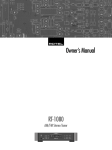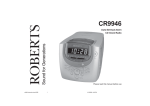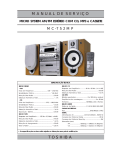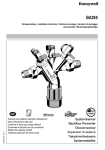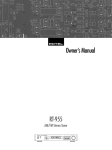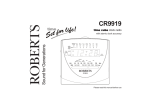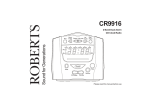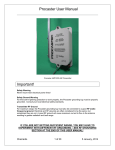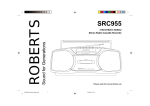Download ffh-286a/ad, fe-286e
Transcript
SERVICE MANUAL MODEL: FFH-286A/AD, FE-286E 3CD CHANGER HI-FI SYSTEM SERVICE MANUAL MODEL : FFH-286A/AD, FE-286E CONTENTS SECTION 1. GENERAL • SERVICING PRECAUTIONS .................................................................................................................... 1-2 • ESD PRECAUTIONS ................................................................................................................................. 1-4 • SPECIFICATIONS ..................................................................................................................................... 1-5 SECTION 2. ELECTRICAL • ADJUSTMENTS ......................................................................................................................................... 2-1 • TROUBLESHOOTING ............................................................................................................................... 2-3 • WAVEFORMS OF MAJOR CHECK POINT .............................................................................................. 2-7 • BLOCK DIAGRAM ................................................................................................................................... 2-17 • SCHEMATIC DIAGRAMS ........................................................................................................................ 2-19 • WIRING DIAGRAM .................................................................................................................................. 2-27 • PRINTED CIRCUIT DIARGAMS .............................................................................................................. 2-29 • INTERNAL BLOCK DIAGRAM OF IC’s ................................................................................................... 2-38 • REPAIRS REGARDING CD MECHANISM ............................................................................................. 2-45 SECTION 3. EXPLODED VIEWS • CABINET AND MAIN FRAME SECTION ................................................................................................. 3-1 • TAPE DECK MECHANISM: AUTO STOP DECK(OPTIONAL) .................................................................. 3-3 • TAPE DECK MECHANISM: AUTO REVERSE DECK ................................................................................ 3-5 • CD MECHANISM ........................................................................................................................................ 3-7 SECTION 4. SPEAKER .................................................................................................................. 4-1 SECTION 5. REPLACEMENT PARTS LIST .................................................................................. 5-1 - 1-1 - SECTION 1. GENERAL SERVICING PRECAUTIONS NOTES REGARDING HANDLING OF THE PICK-UP 1. Notes for transport and storage 1) The pick-up should always be left in its conductive bag until immediately prior to use. 2) The pick-up should never be subjected to external pressure or impact. Storage in conductive bag Drop impact 2. Repair notes 1) The pick-up incorporates a strong magnet, and so should never be brought close to magnetic materials. 2) The pick-up should always be handled correctly and carefully, taking care to avoid external pressure and impact. If it is subjected to strong pressure or impact, the result may be an operational malfunction and/or damage to the printed-circuit board. 3) Each and every pick-up is already individually adjusted to a high degree of precision, and for that reason the adjustment point and installation screws should absolutely never be touched. 4) Laser beams may damage the eyes! Absolutely never permit laser beams to enter the eyes! Also NEVER switch ON the power to the laser output part (lens, etc.) of the pick-up if it is damaged. NEVER look directly at the laser beam, and don’t let contact fingers or other exposed skin. 5) Cleaning the lens surface If there is dust on the lens surface, the dust should be cleaned away by using an air bush (such as used for camera lens). The lens is held by a delicate spring. When cleaning the lens surface, therefore, a cotton swab should be used, taking care not to distort this. Pressure Magnet Pressure How to hold the pick-up Cotton swab Conductive Sheet 6) Never attempt to disassemble the pick-up. Spring by excess pressure. If the lens is extremely dirty, apply isopropyl alcohol to the cotton swab. (Do not use any other liquid cleaners, because they will damage the lens.) Take care not to use too much of this alcohol on the swab, and do not allow the alcohol to get inside the pick-up. - 1-2 - NOTES REGARDING COMPACT DISC PLAYER REPAIRS 1. Preparations 1) Compact disc players incorporate a great many ICs as well as the pick-up (laser diode). These components are sensitive to, and easily affected by, static electricity. If such static electricity is high voltage, components can be damaged, and for that reason components should be handled with care. 2) The pick-up is composed of many optical components and other high-precision components. Care must be taken, therefore, to avoid repair or storage where the temperature of humidity is high, where strong magnetism is present, or where there is excessive dust. 2. Notes for repair 1) Before replacing a component part, first disconnect the power supply lead wire from the unit 2) All equipment, measuring instruments and tools must be grounded. 3) The workbench should be covered with a conductive sheet and grounded. When removing the laser pick-up from its conductive bag, do not place the pick-up on the bag. (This is because there is the possibility of damage by static electricity.) 4) To prevent AC leakage, the metal part of the soldering iron should be grounded. 5) Workers should be grounded by an armband (1MΩ) 6) Care should be taken not to permit the laser pick-up to come in contact with clothing, in order to prevent static electricity changes in the clothing to escape from the armband. 7) The laser beam from the pick-up should NEVER be directly facing the eyes or bare skin. Armband Resistor (1 Mohm) Resistor (1 Mohm) Conductive Sheet CLEARING MALFUNCTION You can reset your unit to initial status if malfunction occur(button malfunction, display, etc.). Using a pointed good conductor(such as driver), simply short the RESET jump wire on the inside of the volume knob for more than 3 seconds. If you reset your unit, you must reenter all its settings(stations, clock, timer) NOTE: 1. To operate the RESET jump wire, pull the volume rotary knob and release it. 2. If you wish to operate the RESET jump wire, it is necessary to unplug the power cord. VOLUME UP RESET jump wire VOLUME KNOB DOWN - 1-3 - ESD PRECAUTIONS Electrostatically Sensitive Devices (ESD) Some semiconductor (solid state) devices can be damaged easily by static electricity. Such components commonly are called Electrostatically Sensitive Devices (ESD). Examples of typical ESD devices are integrated circuits and some field-effect transistors and semiconductor chip components. The following techniques should be used to help reduce the incidence of component damage caused by static electricity. 1. Immediately before handling any semiconductor component or semiconductor-equipped assembly, drain off any electrostatic charge on your body by touching a known earth ground. Alternatively, obtain and wear a commercially available discharging wrist strap device, which should be removed for potential shock reasons prior to applying power to the unit under test. 2. After removing an electrical assembly equipped with ESD devices, place the assembly on a conductive surface such as aluminum foil, to prevent electrostatic charge buildup or exposure of the assembly. 3. Use only a grounded-tip soldering iron to solder or unsolder ESD devices. 4. Use only an anti-static solder removal device. Some solder removal devices not classified as "anti-static" can generate electrical charges sufficient to damage ESD devices. 5. Do not use freon-propelled chemicals. These can generate electrical charges sufficient to damage ESD devices. 6. Do not remove a replacement ESD device from its protective package until immediately before you are ready to install it. (Most replacement ESD devices are packaged with leads electrically shorted together by conductive foam, aluminum foil or comparable conductive materials). 7. Immediately before removing the protective material from the leads of a replacement ESD device, touch the protective material to the chassis or circuit assembly into which the device will by installed. CAUTION : BE SURE NO POWER IS APPLIED TO THE CHASSIS OR CIRCUIT, AND OBSERVE ALL OTHER SAFETY PRECAUTIONS. 8. Minimize bodily motions when handing unpackaged replacement ESD devices. (Otherwise harmless motion such as the brushing together of your clothes fabric or the lifting of your foot from a carpeted floor can generate static electricity sufficient to damage an ESD device). CAUTION. GRAPHIC SYMBOLS THE LIGHTNING FLASH WITH APROWHEAD SYMBOL. WITHIN AN EQUILATERAL TRIANGLE, IS INTENDED TO ALERT THE SERVICE PERSONNEL TO THE PRESENCE OF UNINSULATED “DANGEROUS VOLTAGE” THAT MAY BE OF SUFFICIENT MAGNITUDE TO CONSTITUTE A RISK OF ELECTRIC SHOCK. THE EXCLAMATION POINT WITHIN AN EQUILATERAL TRIANGLE IS INTENDED TO ALERT THE SERVICE PERSONNEL TO THE PRESENCE OF IMPORTANT SAFETY INFORMATION IN SERVICE LITERATURE. - 1-4 - TUNER SPECIFICATIONS SECTION MODEL General Power supply Power consumption Mass Extemal dimensions(W X H X D) CD Frequency Response Signal-to-noise ratio Dynamic range Tuning Range Intermediate Frequency FM Signal-to-noise ratio Frequency Response Tuning Range AM Intermediate Frequency Signal-to-noise ratio Frequency Response AMP Output Power T.H.D Frequency Response Signal-to-noise ratio TAPE Tape Speed Wow Flutter F.F/REW Time Frequency Response Signal-to-noise ratio Channel Separation Erase Ratio Speaker MODEL Type Impedance Frequency Response Sound Pressure Level Rated Input Power Max.Input Power Net Dimension(W X H X D) Net Weight FFH-286A/AD Refer to the back panel of the unit 30W 5.70kg 273 X 330 X 360mm 40-18000Hz 70dB 70dB 87.5-108.0MHz or 65-74MHz, 87.5-108.0MHz 10.7 MHz 61/58dB 60-10000Hz 522-1611kHz or 530-1610kHz 450kHz 35 dB 100-2000 Hz 5W + 5W 0.3% 42-20000Hz 80dB 4.75cm/sec 0.25% (MTT-111,JIS-WTD) 120sec(C-60) 250-8000Hz 43dB 50dB(P/B)/45dB(R/P) 55dB (MTT-5511) FE-286E 1 Way 1 Speaker 4Ω 80-20000Hz 86dB/W(1m) 5W 10W 180 X 326 X 165.8mm 1.67kg NOTE : Specification are subject to change without notice in the course of product improvement. - 1-5 - MEMO - 1-6 - SECTION 2. ELECTRICAL ADJUSTMENTS This set has been aligned at the factory and normally will not require further adjustment. As a result, it is not recommended that any attempt is made to modificate any circuit. If any parts are replaced or if anyone tampers with the adjustment, realignment may be necessary. IMPORTANT 1. Check Power-source voltage. 2. Set the function switch to band being aligned. 3. Turn volume control to minimum unless otherwise noted. 4. Connect low side of signal source and output indicator to chassis ground unless otherwise specified. 5. Keep the signal input as low as possible to avoid AGC and AC action. TAPE DECK ADJUSTMENT 1. AZIMUTH ADJUSTMENT Deck Mode Test Tape Test Point Adjustment Adjust for A Deck Playback MTT-114 Speaker Out DECK Screw Azimuth Screw Maximum B Deck Playback MTT-114 Speaker Out Azimuth Screw Maximum Electronic Voltmeter Head Playback Mode Speaker Out L out L ch Test Tape MTT-114 Dual-trace synchroscope CH1 CH2 Unit R ch GND R out Figure 1. Azimuth Adjustment Connection Diagram 2. MOTOR SPEED ADJUSTMENT Deck Mode Test Tape Test Point Adjustment Adjust for Remark Normal Speed MTT-111 Speaker Out VR201 3kHz ± 1% A Deck HI-Speed MTT-111 Speaker Out Head more than 5.4kHz Playback Mode Speaker Out Frequency Counter L out Test Tape MTT-111 Unit Record/Playback head R out GND Figure 2. Motor Speed Adjustment Connection Diagram - 2-1 - HI-Speed Dubbing Mode 3. RECORD BIAS ADJUSTMENT Deck Mode Test Tape Test Point Adjustment Adjust for Rec/Pause MTT-5511 ERASE HEAD WIRE(PN202) L203 60kHz±5kHz (Auto stop) 85kHz±5kHz(Auto Reverse) Record/Playback and Pause Mode Head Test Tape MTT-5511 PN202 Frequency Counter Unit GND Record/Playback head Figure 3. Record Bias Adjustment Connection Diagram 4. TUNER ADJUSTMENT (FM) Item Test Point Adjustment Adjust for DC Voltage Checker IC Pin 26, 28 L106 0V±50mV Electronic OSCILLOSCOPE FM Antenna Terminal Speaker Signal Generator Unit GND Figure 4. Tuner(S curve) Adjustment Connection Diagram - 2-2 - TROUBLESHOOTING Turn power on. Check power supply circuit. PN807 PIN5, 6.2V PN807 PIN7, 5V IC803 PIN 2, 3.3V NO Is power on? YES NO Does initial read work? NO Check the DISK turns YES Check the connector PN801, PN802, PN809 Check the Laser YES YES Check the focus circuit YES Check the TRAKING circuit Does it play? NO Check the tracking servo circuit. YES Does it output audio? NO OK - 2-3 - Check the PN807 PIN1, 3 Fails to initial read NO Disc motor turns Check the Voltage change of PN 809 PIN20(OPEN, CLOSE) NO Defective connector PN809 YES YES Does RF waveform appear? IC801 Pin3 Check the Data transmission from PN809 pin11 to CD DSP NO NO 5V 0V Defective connector PN809, Defective MICOM YES Check the Data transmission from PN809 pin13 to MICOM 5V NO Defective connector PN809, Defective IC801 NO Defective IC801 NO Defective IC802 0V YES Check the change of SLDO Voltage(IC801 pin23) 2V 1V 0V YES YES Check the change of SL +, SL - Voltage (IC802 pin 18, 19) 1.2V 0V 0.8V YES Does laser light? A YES Does FA+ waveform appear at IC802 pin13? Defective contact PN802 Defective PICK-UP NO focus coil drive wareform. YES Does TE waveform appear at 801 pin 15? NO B TRACKING ERROR wareform YES Is rotation normal? NO YES Is there no dropout of RF signal? YES - 2-4 - Defective IC801 Defective PICK-UP Laser does not light. Is “3.5V” applied to pin 70 of IC 801? NO YES Did pickup return to innermost circular? NO NO Is data transferred from MICOM IC ? YES Defective MICOM. YES Does voltage appear at IC 802 pin 17, 18? NO YES Does it stop at inner pick circular after shift? YES Defective slide motor and/or connector. Is defect output from LM SW applied to pin 2 of PN802? OPEN Defective IC 801, 802 NO Defective LMT SW and/or connector. CLOSE YES Defective MICOM. YES NO Defective connector. Is power supplied to laser Q801? (Q 801 collector: about 1.8V) YES Does laser current flow? 1.0V across R808 R808»1.0V R808«1.0V - 2-5 - YES YES Defective Q 801 and/or laser. Defective laser and/or connector. B Laser lights NO Does lens move up/down? YES NO Defective IC801 Check the signal of FOCUS SEARCH (IC801 Pin 21) YES NO Chekc the signal of PN802 pin 13, 14 Open activator and/or connector YES Does FE signal appear? (IC801 pin 13) Defective IC802 NO Defective IC801 YES NO Does DRF signal appear? (IC 801 pin67) - 2-6 - Degraded laser diode Defective PICK-UP WAVEFORMS OF MAJOR CHECK POINT 1. HF signal (RF signal ) waveform (IC801 pin 3) during normal play 2. EFM signal (IC801 pin 3)waveform during Normal Play ( 0.5V/Div. 500nS/Div. ( 0.5V/Div. 5µS/Div. OV OV 3. Focus coil drive waveform(IC802 pin13) • When focus search failed or there is no disc on the tray • Focus coil drive waveform(FDO: IC801 pin21) and DRF(IC801 pin67) when focus search is accomplished ( 1S/Div. 1V/Div. OV (CH1) OV OV (CH2) ( CH1 : FOCUS COIL DRIVE SIGNAL 2V/Div. CH2 : DRF (2) When time division 1mS/Div, 1V/Div (During forward track traverse) 4. Tracking coil drive waveform and TE during track traverse (1) When time division is 20mS/Div.1V/Div. ( OV (CH1) OV (CH1) OV (CH2) OV (CH2) ( CH1 : TRACKING COIL DRIVE (IC802 pin27) CH2 : TRACKING ERROR (TE: IC801 pin15) CH2 : TRACKING ERROR (TE: IC801 pin15) 1V/Div. 5. Feed motor drive waveform(IC 802 pin18) During normal play (3) When time division is 0.5nS/div. (During backward Track Traverse) ( 1mS/Div. 1V/Div. ( 2S/Div. 0.5V/Div. OV OV OV (CH2) ( CH2 : TRACKING COIL DRIVE (IC802 pin27) SIGNAL 2V/Div. CH1 : TRACKING COIL DRIVE SIGNAL 2V/Div. (IC802 pin27) CH2 : TRACKING ERROR(TE: IC801 pin15) 1V/Div. - 2-7 - P-SENS PART Does +5V appear at ZD701? Check the waveform of D713(Cathod). NO YES NO YES Check the pattern of IC301 Pin 14 . Replace the D713 Check the 5.6K of R714 and replace ZD703(5.1V) VKK PART Does DC - 33V appear at CN302 Pin 28 . NO YES Dose -33V appear at ZD704(-) NO YES Check the Voltage of IC301 PIN 51 . Replace the ZD704(-33V) Check the Q715 TURN ON Check the -33V(LOW) of C704 Replace the D714, D718, D715 Check the PATTERN Replace the Q715 Refer to power circuit END - 2-8 - Power Circuit Check the Fuse NO YES Check the DC output C736 NO Replace the Fuse Check the AC output of CN701 Pin4, 5 NO Check the power Ass’y or Replace the Transformer YES YES Replace the D745, D746, D747, D748 Check the DC Output of C738 NO YES Check the AC Output of CN701 PIN 1, 3 NO Check the power Ass’y or Replace the Transformer NO Check the 5V of IC301 PIN 17,46,72,90 NO Check the High of IC301 Pin 3. YES Check the output of IC703, IC782, IC783 YES Check the D741, D742, D744, D734 or Replace. NO Check the IC703, IC782, IC783 or Replace. YES Check the 5V of CN513 Pin 7 (CD FUNCTION) YES END Replace the IC782 NO Check the Q713 “B”:HIGH, Q711 “B”:LOW YES Replace the Q713, Q711 NO YES Check the High of Q713 “B” or Replace Check the IC301 or Replace - 2-9 - Muting circuit (MUTE) Dose “High” appear at Q712 “E” YES NO Check the “High” of Q712 “C” check the “High” Q721, Q771, “B” Replace the TR YES MUTE Audio abnormal Check the output of IC701 Pin 26, 27 YES NO Refer to “IC701 Troubleshooting” NO Refer to “Muting Troubleshooting” Check the input of IC702 Pin 2,4 (L-CH/R-CH) YES Check the Output of IC702 Pin 12, 8 (L-CH/R-CH) YES Check the “High” of IC702 Pin 5. Check the Voltage of IC702 Pin 7. Check the power circuit. NO END - 2-10 - FUNCTION MODE Audio abnormal TAPE AUX Check the signal input of IC401 pin 28, 37 Chekc the signal input of IC401, pin 29, 36 Refer to “IC202 Troubleshooting” Check the signal input of JK401 CD Tuner Check the signal input of IC401 pin 31, 34 Check the signal input of IC401 pin 30, 35 Check the signal of CN513 Pin 1, 3 or Refer to “CD Troubleshooting” Refer to “IC102 Troubleshooting” MIC Check the “LOW” of Q205 “B” Refer to “IC504 Troubleshooting” - 2-11 - IC301 Troubleshooting Check the power supplying IC301 Pin 17, 46, 90? NO YES Refer to “Power Circuit Troubleshooting” Check the 5V of IC301 pin26 NO Check the P-SENS YES Check the oscillation of X301 NO Replace the X301 YES When power supplying to IC301 pin17. (High ➞ Low ➞ High) NO Check the RESET circuit YES Replace the IC301 IC203 Troubleshooting Check the power supplying to IC203 pin 16 NO Refer to “Power Circuit Troubleshooting” YES Check the CLK Data of IC203 pin 2, 3 NO Check the Data of IC301 Pin 3, 4, (CD ➞ TAPE FUNCTION) YES Check the CONTROLL function NO YES Refer to “IC301 Troubleshooting” Replace the IC203 END - 2-12 - Check the pattern of (IC301, IC203) IC401 Troubleshooting Check the power of IC401 Pin29. YES Check the Pulse of IC401 Pin21,22 YES NO Check the IC301 Pin85,86,75,76 YES Check the signal output of IC401 Pin 32,33 YES NO Refer to “IC301 Troubleshooting” Check the PATTERN of MICOM (85,86) IC401 Pin 21,22 Replace the IC401 Check the Signal output of pin25, 24 YES NO NO Replace the IC401 OK FM (TUN101) Check the 10V input of TUN101 B+ 6 Check the 12V of Q102 “E” YES NO YES Refer to “Power Circuit Troubleshooting” Check the “LOW” of IC103 Pin 7 Check the “High” Voltage of TUN101 VT(5PIN) YES NO Replace the Q102 YES Replace the TUN101 Check the OSC waveform of TUN101 Pin 8 Replace the TUN101 YES Refer to “IC102 Troubleshooting” - 2-13 - Refer to “IC103 Troubleshooting” IC102 Troubleshooting Is power supplied to pin8(10V) NO YES Refer to “Power Circuit Troubleshooting” Check the waveform of Pin 20, 21 NO Check the FM(TUN101) & AM(L107) YES NO Replace the IC102 Check the output of Pin 16, 17 NO Check the “Low” of Pin 13 YES NO YES END Replace the IC102 IC103 Troubleshooting Check the power supplying to pin 17 NO YES Refer to “Power Circuit Troubleshooting” Check the oscillation of X104 NO Replace the X104 YES Check the waveform of CE, DI, DO, CLK NO YES Is the normal ? Check the line or refer to “IC 301 Troubleshooting” CE: Chip Enable DI: Data Input(from u-com) DO: Data Output(to u-com) CLK: Tuner mode clock NO Replace the IC103 YES END - 2-14 - Refer to “IC103 Troubleshooting” AM•COIL Troubleshooting Check the “High” of L107 Pin 2 NO Refer to “IC103 Troubleshooting” YES Check the oscillation of L107 Pin 13 NO Replace the L107 YES Refer to “IC102 Troubleshooting” Play Check the VCC supplying to IC202 pin 18 NO YES Refer to “Power Circuit Troubleshooting” Check the signal output of IC202 pin 5, 20 NO Check the Deck Mecha YES NO Check the Muting Circuit YES Replace the Deck Mecha. Replace the IC202 Dubbing(“NORMAL or REC “//“HIGH”) Q252, 202 “OFF”//“ON” : R273, 223 “LOW”//“HIGH YES Q253, 203 “ON”//“OFF” NO YES Refer to “REC Troubleshooting” - 2-15 - Refer to “IC203 Troubleshooting” REC (Q252, Q202 ON / R273, R223 High) Check signal supplied to IC202 pin 11, 14? NO YES Check the “Low” of Q253, Q203 “B” NO YES Refer to “IC203 Troubleshooting” Replace the Q253, Q203 Check the output of IC202 Pin9, 16 NO YES Check the Vcc power of IC202 Pin18 Check the IC201 pin6 : 12V and pin 4 : High NO YES Check the power or Refer to “IC203 Troubleshooting” Check the oscillation of L203 pin 2, 3 NO YES Check the power supplying to C236(+) NO Replace the DECK YES Refer to “Power Circuit Troubleshooting” Check the 0.6V of Q208 “B” NO YES Refer to “IC203 trouleshooting” Check the “Low” of Q208 “C” NO Replace the Q208 YES Replace the Q207 NO YES END - 2-16 - Replace the L203 BLOCK DIAGRAM NOTE: Warning Parts that are shaded are critical With respect to risk of fire or electrical shock. 2-17 2-18 NOTE: 1. Shaded(■) parts are critical for safety.Replace only with specified part number. 2. Voltages are DC-measured with a digital voltmefer during Play mode. SCHEMATIC DIAGRAMS • MAIN SCHEMATIC DIAGRAM NOTE: Warning Parts that are shaded are critical With respect to risk of fire or electrical shock. 2-19 2-20 NOTE: 1. Shaded(■) parts are critical for safety.Replace only with specified part number. 2. Voltages are DC-measured with a digital voltmefer during Play mode. • FRONT SCHEMATIC DIAGRAM 2-21 2-22 • TUNER/DECK SCHEMATIC DIAGRAM 2-23 2-24 • CDP SCHEMATIC DIAGRAM 2-25 2-26 WIRING DIAGRAM NOTE: Warning Parts that are shaded are critical With respect to risk of fire or electrical shock. 2-27 2-28 PRINTED CIRCUIT DIAGRAMS • MAIN P.C. BOARD (SOLDER SIDE) 2-29 2-30 • MAIN P.C. BOARD (COMPONENT SIDE) 2-31 2-32 • FRONT P.C. BOARD(COMPONENT SIDE) 2-33 2-34 • FRONT P.C. BOARD(SOLDER SIDE) 2-35 2-36 • CD MAIN P.C. BOARD • AMP & POWER P.C. BOARD NOTE: Warning Parts that are shaded are critical With respect to risk of fire or electrical shock. - 2-37 - INTERNAL BLOCK DIAGRAM OF ICs ■ FAN8039BD3 5-CH Motor Diver Description DO 5- DO 5+ GND2 22 DO 3- 2 23 DO 3 + 2 24 IN3 25 FIN (GND) VCC1 IN4 26 PS DO 4+ 27 VREF DO4- 28 VCC GND3 The FAN8039BD3 is a monolithic integrated circuit suitable for a 5-CH motor driver which drives the tracking actuator, focus actuator, sled motor, tray motor, spindle motor of the DVDP/CAR-CD systems. 21 20 19 18 17 16 15 10K PS RESX Level Shift 10K 2 2 FUNCTION H H All Active H L Reg. Only Deactive L H Reg. Only Active L L All Deactive Level Shift Level Shift 10K Regulator 2.5V 10K 10K TSD Level Shift 6 7 DO1- DO1+ IN1 REGVCC REB REO RESX 8 FIN (GND) 9 10 11 2 12 13 14 DO 2- 5 REV 4 FWD 3 CTL 2 GND1 1 2 DO 2+ 10K 2 IN2 2 Level Shift COMP Pin Definitions NO Symbol Description NO Symbol 1 DO1- CH1 Drive Output (-) 2 DO1+ 3 IN1 4 REGVCC 5 6 Description 15 GND2 CH1 Drive Output (+) 16 DO5+ CH5 Drive Output (+) CH1 Drive Input 17 DO5- CH5 Drive Output(-) Regulator Supply Voltage 18 DO3- CH3 Drive Output(-) REB Regulator Output 19 DO3+ CH3 Drive Output (+) REO Regulator Feedback Input 20 IN3 7 RESX Regulator Reset 21 VCC1 8 GND1 Signal Ground 22 PS Power Save 9 CTL CH5 Motor Speed Control 23 VREF Bias Voltage 10 FWD CH5 Forward Input 24 VCC Supply Voltage(CH1,CH4) 11 REV CH5 Reverse Input 25 IN4 CH4 Drive Input Power Ground1 (CH 2,3,5) CH3 Drive Input Supply Voltage1(CH2,CH3,CH5) 12 IN2 CH2 Drive Input 26 DO4+ CH4 Drive Output (+) 13 DO2+ CH2 Drive Output (+) 27 DO4- CH4 Drive Output (-) 14 DO2- CH2 Drive Output (-) 28 GND3 Power Ground2 (CH 1,4) - 2-38 - ■ KA78R33 Low Dropout Voltage Regulator Description The KA78R33 is a low-dropout voltage regulator suitable for various electronic equipments. It provides constant voltage power source with TO-220 4 lead full mold package. Dropout voltage of KA78R33 is below 0.5V in full rated current(1A). This regulator has various function such as peak current protection, thermal shut down, overvoltage protection and output disable function. Internal Block Diagram Vin Q1 1 THERMAL SHUTDOWN BANDGAP REFERENCE 2 OVERVOLTAGE PROTECTION + R1 SOA PROTECTION HIGH / LOW Vdis 4 + OUTPUT ON / OFF 1.4V - CIRCUIT SHORTCIRCUIT PROTECTION 3 GND ■ LC72131 AM/FM PLL Frequency Synthesizer - 2-39 - R2 Vo Block Diagram XIN REFERENCE DIVIDER PHASE DETECTOR CHARGE PUMP SWALLOW COUNTER 1/16. 1/17 4bits UNLOCK DETECTOR PD XOUT AIN 1 FMIN 2 AOUT 12bits PROGRAMMABLE DIVIDER AMIN CE DI CCB DATA SHIFT REGISTER LATCH I/F UNIVERSAL COUNTER IFIN CL D0 POWER ON RESET VDD VSS B01 B02 B03 B04 I01 I02 ■ LA1837 Single-Chip Home stereo IC with Electronic Tuning Support The LA1837 is a single-chip AM/FM IF and MPX IC that supports electronic tuning and was developed for use in home stereo systems. It is optimal for use in automatic station selection systems that use the SD and IF counting techniques. FM SD ADJ Block Diagram 3 rd 5 th FM DECODER ANTI-BIRDIE - 2-40 - ■ KIA 78R12 PI 4 TERMINAL LOW DROP VOLTAGE REGULATOR The KIA78RXX Series are Low Drop Voltage Regulator suitable for various electronic equipments. It provides constant voltage power source with TO-220 4 termainal lead full molded PKG. The Regulator has multi function such as over current protection, overheat protection and ON/OFF control. - 2-41 - Block Diagram ■ KIA7805AP/API THREE TERMINAL POSITIVE VOLTAGE REGULATORS 5V, 6V, 8V, 9V, 10V, 12, 15V, 18V, 24V. EQUIVALENT CIRCUIT - 2-42 - ■ BA3126N 2-channel head switch for radio cassette recorders - 2-43 - ■ BU2090F 12-bit, Serial IN, Parallel OUT driver Block diagram Vss 1 Control circuit DATA 2 12-bit shift register CLOCK 3 16 VDD 15 Q11 14 Q10 Latch Q0 4 13 Q9 Output buffer (open drain) Q1 5 12 Q8 Q2 6 11 Q7 Q3 7 10 Q6 Q4 8 9 Q5 PIN DESCRIPTION Pin No. BU2090/F/FS BU2092/F Pin name Function BU2092/FV 1 1 1 Vss GND 2 2 2 DATA 3 3 3 CLOCK Data shift clock input - 4 4 LCK Data latch clock input 4 5 5 Q0 parallel data output 5 6 6 Q1 parallel data output 6 7 7 Q2 parallel data output 7 8 8 Q3 parallel data output Serial data input 8 9 9 Q4 parallel data output 9 10 10 Q5 parallel data output 10 11 11 Q6 parallel data output - - 12 N.C. Not connected - - 13 N.C. Not connected 11 12 14 Q7 parallel data output 12 13 15 Q8 parallel data output 13 14 16 Q9 parallel data output 14 15 17 Q10 parallel data output 15 16 18 Q11 parallel data output - 17 19 OE Output Enable 16 18 20 VDD Power supply - 2-44 - REPAIRS REGARDING CD MECHANISM IMPROVED METHOD - WHEN THE TRAY GEARS WERE DISTORTED 1. How to open the tray. In case of not suppling power push two hooks (H) of the base, and them open the tray. 2. How to improve the distorted gears. (1) Do the hole "C" of the cam gear to face forward the pick-up so the pick-up is down like figure. (2) Do the hole "B" of main gear to face forward pick-up, too. (3) Set the last part of main gear to point "A". (4) Push the tray to end. - 2-45 - MEMO - 2-46 - SECTION 3. EXPLODED VIEWS NOTE) Refer to “SECTION 5 REPLACEMENT PARTS LIST” in order to look for the part number of each part. • CABINET AND MAIN FRAME SECTION 353 A26 351 301 257 354 454 261 291 A41 454 A46 454 310 292 293 260 305 294 286 302 (Option) 303 A43 264 454 285 277 284 (Option) 354 A00 250 279 286 280 454 454 278 454 3-1 3-2 • TAPE DECK MECHANISM: AUTO STOP DECK(OPTIONAL) 400 505 404 021 020 006 019 001 400 002 018 016 017 003 022 004 005 007 402 008 014 A01 405 010 023 015 009 401 502 501 024 026 403 025 504 013 032 401 503 031 011 400 409 027 406 401 408 028 030 407 029 3-3 3-4 • TAPE DECK MECHANISM: AUTO REVERSE DECK 400 505 404 021 020 006 019 001 400 018 002 016 017 003 022 004 037 005 506 007 402 008 014 A01 508 507 405 010 023 015 009 401 502 501 024 026 403 025 504 013 032 038 027 401 040 503 031 011 028 406 039 400 410 029 034 409 035 036 3-5 3-6 • CD MECHANISM 416 151 159 156 422 418 165 419 164 153 163 170 155 171 173 168 162 417 169 166 417 167 416 A30 421 184 421 421 177 184 172 184 417 175 421 417 184 3-7 185 3-8 SECTION 4. SPEAKER SECTION MODEL: FE-286E 850 852 854 855 856 857 - 4-1 - MEMO - 4-2 -

















































